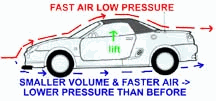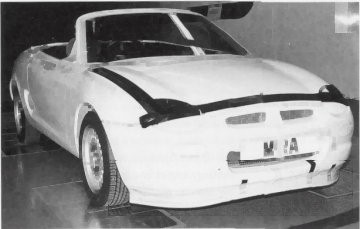
|
Words and Pictures: Rob Bell |
Contents: Introduction | Theory | Do splitters work
 |
MGF Aerodynamics
Contents: Introduction | Theory | Do splitters work |
In common with all modern cars, the MGF has been designed with aerodynamic efficiency in mind (see figures of how efficient various models of MGF are here). The rewards from such an approach is improved top speed and fuel economy. But apart from being a slippery shape, a car must also must avoid acting like an aircraft wing, namely generating lift, and avoid large shifts in the pressure areas over the surfaces of the car in cornering and braking. As we shall see, the MGF's styling was signed off before MIRA wind testing (a side effect of a tight development budget and speedy gestation time). This has not been without consequence.
Many have noticed that when driving their MGF at motorway speeds the steering becomes light and the car can feel unsteady in cross winds. Less obvious is the modest degree of under-steer that afflicts the F in faster corners. The cause of these characteristics is aerodynamic lift.
|
Project Phoenix: the birth of the MGF |
In the book, ‘Project Phoenix’ (pages 186-7)
an aerodynamic aid is described
and pictured,
 attached to the
bottom of the front bumper. This was said to dramatically improve the handling of an
otherwise standard F. For a number of reasons, this aerodynamic ‘spoiler’ failed
to make it through to production (although a spoiler that looks remarkably similar to
a front air-dam type spoiler produced by Mike Satur), although a
vestigial under bumper spoiler was tacked on to curb this phenomenon (an
addition that also improves airflow through the front mounted radiator).
attached to the
bottom of the front bumper. This was said to dramatically improve the handling of an
otherwise standard F. For a number of reasons, this aerodynamic ‘spoiler’ failed
to make it through to production (although a spoiler that looks remarkably similar to
a front air-dam type spoiler produced by Mike Satur), although a
vestigial under bumper spoiler was tacked on to curb this phenomenon (an
addition that also improves airflow through the front mounted radiator).
The rear of the car, as originally styled, was found to be
remarkably effective in reducing lift during MIRA wind testing. The cut-off rear end
with a long rear deck (a by-product of the engine location and the need for a
rear storage compartment) fortunately resulted in an aerodynamic effect called a 'Kamm-tail' (this can also be seen on numerous 1960's
Alfas- like the Spider - see info box below). For the designers, this was great
news, as no aerodynamic modification was required - keeping the styling true to
Gerry McGovern's original sketches. It also means that a rear spoiler on an F is therefore probably
useful only as a pleasing aesthetic device.
| The Kamm Tail |
| Aerodynamic Theory |
 |
Wing versus Spoiler
A front-mounted splitter (such as Krafthaus/KH Assemblies splitter, or that made my MG themselves for the MGF Trophy), falls into the latter category - it is a spoiler. The name, "splitter," is derived from the effect it has on splitting the stationary air as the vehicle travels forward- forcing more air to travel over the upper rather than lower surfaces of the bodywork. Effectively, the splitter is spoiling the the natural airflow path to the benefit of aerodynamic efficiency.
How does a Splitter work?
|
Air moving over the upper surfaces of the car has to travel further than air under the vehicle, and therefore has to travel faster. The upper surfaces of a car tend to be smooth - which helps aid this rapid movement of air. In contrast, however, air movement under the car tends to travel more slowly, not only because it doesn't have to travel as far, but because, on the majority of production cars, the under side of the vehicle is not smooth at all - with particularly obstructive paths and therefore high drag around suspension and transmission components. This can lead to particularly unfavourable situation where stagnant, high-pressure ‘pools’of air form.
Bernoulli′s Principle of lift tells us that fast moving air is at a lower pressure than slow or still air - a principle key to the development of lift that characterises the aircraft wing. Low pressure over the top of the car combined with relatively higher pressure under the car generates small, but discernible lift, which is exerted over the whole area of the car (1.63 x 3.91m = 6.37m2).
|
|
If there were a way of reducing the amount of air travelling under the vehicle, the resultant movement of air under the car would be faster and at lower pressure, reducing the pressure gradient over the upper and lower surfaces.
Effectively, the splitter achieves exactly this result: rather like an air dam, it diminishes the amount of air travelling under the vehicle, thus permitting what air does pass under this surface to travel faster with less chance of stagnation.
Any device that limits this differential will have a favourable effect upon reducing aerodynamic lift. However, it is crucial to realise that altering lift at one end of the vehicle, such as adding a spoiler to the front bumper, could seriously effect the balance of the vehicle as a whole; the balance of the whole could become unbalanced, causing serious high-speed handling instability. In the case of the MGF (and to a much lesser extent, the TF), the front-end lift is far greater than observed at the rear, to the extent that any of the official or aftermarket aerodynamic aids are unlikely to influence aerodynamic balance adversely - and indeed appear to be beneficial overall.
| Do front aerofoils work? |
 |

If you are about to splash your hard-earned cash on a spoiler, it would be comforting to know whether the thing actually works as is suggested. Unfortunately, independent access to MIRA's wind tunnels is not particularly practical unless you've got some Lottery millions burning a hole in your pocket (if you have, I can certainly suggest better ways of spending it!). However, feedback from fellow MG-owning enthusiasts can be helpful.
In the case of the two front spoilers that represent the majority of the market, the KH assemblies splitter (as sold by Brown and Gammons) and the MG Rover 'Trophy' front spoiler (available as OEM or reproduction, from a variety of sources), it seems that the overall impression is favourable.
Certainly, the KH splitter, in my own experience, works well. I felt a difference immediately after fitting it; the splitter resulted in a far greater feeling of security at motorway speeds, and dramatically less under-steer in faster corners. Another spin off that I have found is that the steering feel is much better at any speed above 50mph.
Similar reports have been made regarding the MG splitter -
so perhaps the choice really boils down to aesthetic preference. Some have even
sought to combine the two - as Erik as done - see opposite and
here.